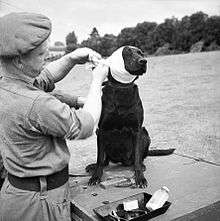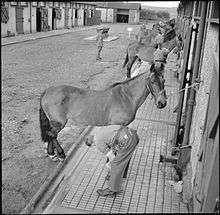Royal Army Veterinary Corps
The Royal Army Veterinary Corps (RAVC), known as the Army Veterinary Corps (AVC) until it gained the royal prefix on 27 November 1918, is an administrative and operational branch of the British Army responsible for the provision, training and care of animals. It is a small corps, forming part of the Army Medical Services.
| Royal Army Veterinary Corps | |
|---|---|
 Cap badge of the Royal Army Veterinary Corps incorporating Chiron | |
| Active | 1796–present |
| Country | |
| Allegiance | |
| Role | Animal Healthcare |
| Garrison/HQ | Defence Animal Training Regiment, Melton Mowbray, Leicestershire |
| Nickname(s) | RAVC |
| March | Drink Puppy Drink / A-Hunting We Will Go (Quick); Golden Spurs (Slow) |
| Equipment | Dogs, horses |
| Commanders | |
| Colonel-in-Chief | The Princess Royal |
| Insignia | |
| Tactical Recognition Flash |  |
History

The original Army Veterinary Service (Veterinary Corps) within the Army Medical Department was founded in 1796 after public outrage concerning the death of Army horses. John Shipp was the first veterinary surgeon to be commissioned into the British Army when he joined the 11th Light Dragoons on 25 June 1796.[1]
The Honorary Colonel-in-Chief is the Princess Royal who has visited RAVC dog-handling units serving in Afghanistan.[2]
In late March 2016, the Ministry of Defence announced that Fitz Wygram House, one of the Corps' sites, was one of ten that would be sold in order to reduce the size of the Defence estate.[3]
Function
.jpg)
The RAVC provides, trains and cares for mainly dogs and horses, but also tends to the various regimental mascots in the army, which range from goats to an antelope. Personnel include veterinary surgeons and veterinary technicians providing medical and surgical care to animals, and handlers who train dogs and deploy with them on operational service. Dogs are used extensively in the theatre of war, and are organised within the 1st Military Working Dog Regiment (see below). Horses are used primarily for ceremonial purposes, although the Corps continues to rehearse procedures for the operational deployment of horses. This is explained on its website in these terms:
Although there is unlikely ever be a significantly large requirement for equines in future military operations, there are scenarios where ground conditions, (in situations where stealth is required or helicopters are not available for example), could make pack transport a vital solution to the need.[1]
Structure

The main location for the RAVC is at Melton Mowbray in Leicestershire, although staff are spread throughout the Army. They are also responsible for explosives and drug search dogs.
The Corps has subsidiary regiments:
Honours
Sadie, a black labrador retriever belonging to 102 MWDSU and cared for by handler Lance Corporal Karen Yardley, won the PDSA Dickin Medal ("the animal's VC") in 2007.[5]
On 24 July 2008, Lance Corporal Kenneth Michael Rowe of the RAVC and attached to 2nd Battalion, The Parachute Regiment was killed along with his search dog Sasha, during a contact with the Taliban in Helmand Province, Afghanistan.[6]
In February 2010, Treo, a black Labrador-Spaniel crossbreed, was awarded the Dickin Medal for services in Afghanistan.[7]
In 2011 Lance Corporal Liam Tasker of 104 MWD Squadron was killed in Helmand Province, Afghanistan. He was posthumously mentioned in despatches. His Arms Explosive search dog, Theo, died shortly afterwards. Theo was posthumously awarded the Dickin Medal on 25 October 2012.[8]
Memorials

A memorial to the RAVC and its predecessors was unveiled at the National Memorial Arboretum on 2 May 2014 by the Princess Royal. Seven memorial stones in remembrance of the five dog handlers who lost their lives while serving in Northern Ireland and the two dog handlers who were killed while on operations in Afghanistan have been placed at their base in North Luffenham.[9]
Heads of the Corps
Directors-General of the Army Veterinary Department
- 1897–1902: Veterinary-Colonel Francis Duck, CB
- 1902– : Major-General Henry Thomson, CB[10]
- 1910-1917: Sir Robert Pringle, KCMG, CB, DSO
Order of precedence
| Preceded by Adjutant General's Corps |
Order of Precedence | Succeeded by Small Arms School Corps |
References
- "A brief history of RAVC". Retrieved 9 May 2014.
- Faulkner, Katherine (2 March 2010). "Princess Anne gets to grips with Britain's canine soldiers in surprise visit to Afghanistan troops". The Daily Mail. London: Associated Newspapers.
- "Thousands of new homes to be built as MOD releases more sites". Ministry of Defence. Retrieved 25 March 2016.
- "1st Military Working Dog Regiment". British Army. Archived from the original on 28 December 2011. Retrieved 25 December 2011.
- "Sniffer dog rewarded for bravery". BBC News. 7 February 2007. Retrieved 3 March 2011.
- "Army dog killed in Afghanistan given posthumous medal". BBC. 29 April 2014. Retrieved 9 May 2014.
- "Treo the dog awarded animal VC". The Daily Telegraph. Telegraph Media Group. 6 February 2010. Retrieved 24 February 2010.
- "Dead soldier Liam Tasker and Army dog return home". BBC. 10 March 2011. Retrieved 9 May 2014.
- "Royal Army Veterinery [sic] Corps Memorial. North Luffenham". Palace Barracks Memorial Garden.
- "No. 27491". The London Gazette. 4 November 1902. p. 7015.
Further reading
- Clabby, John, Brigadier (1963). The History of the Royal Army Veterinary Corps, 1919–1961. London: J.A. Allen & Co. p. 244.
- Milne, F.J. (September 1963). "Review of The History of the Royal Army Veterinary Corps 1919–1961". The Canadian Veterinary Journal. 4 (9): 235. PMC 1695409.
- Smith, Frederick, Major-General Sir (1927). A History of the Royal Army Veterinary Corps, 1796–1919. London: Baillière & Co. p. 268.